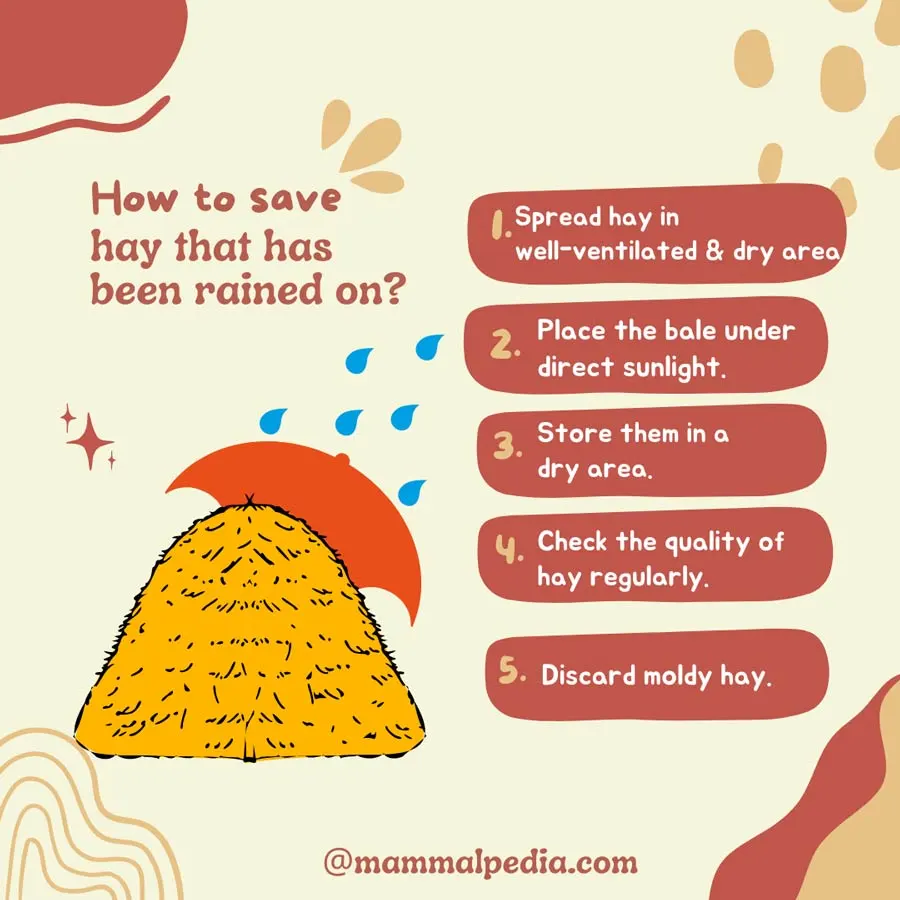The weather forecast has changed, and the hay field got rained on, a lotttttttt!!!!
Every farmer’s nightmare.
Weather shocks are a common phenomenon and make farmers’ lives a living hell.
Let me take a wild guess, you caught up in one of those nasty situations when you cut the hay for baled and rains interrupt your whole plan.
I can feel your pain, man.
And if you are in the livestock business, you are probably wondering if it is still safe to use as feed. Can horses eat hay that has been rained on?
Well, I was also in the same boat and was struggling a lot and trying to find different coping strategies to give my horses the best feed possible. And this article is all about dealing with the hay damaged by rain for livestock like horses and cattle and wet feeding hay to horses.
So, can horses eat wet hay?
Yes, you can use wet hay as horse feed as long as your hay is not moldy and your horse is not prone to colic, you can feed wet hay to horses. But wet hay is not as nutritious as fresh hay. Hay that has been rained on can also be affected by fungus, which can cause an increase in inflammation in the horse’s stomach.
Before feeding wet hay to horses, the first thing you need to do is, check the quality of the hay.
But how?
The process is pretty simple, actually.
You can use the damp hay as normal if its condition is good. While discarding the wet hay in the case of poor condition or too much-wet hay,
Now, how do we determine the quality of wet hay? Follow the below steps.
- Step 01: Grab a handful of wet hay.
- Step 02: Squeeze it tightly.
- Step 03: If water drips from the wet hay, it is too wet, and you must discard it without fail. On the flip side, if you don’t see water drips, it is in good condition and can be fed to horses.
Let’s not forget………
Wet Hay lacks nutrient value and carbohydrates. So, don’t feed your horse a large amount of wet hay. Also, it would always be best to feed dry hay. Therefore, try to dry the wet hay as much as possible before feeding.

What happens to hay if it gets wet?
According to research by Michael Collins of the University of Kentucky, the reduction of protein and digestible nutrients can be 3% and 4.6%, respectively, in wet hay. Moreover, your horse cannot digest wet hay; digestibility reduces up to 10% because of nutrient loss and shattered leaves.
Wet Hay can lose quality in 4 different ways, including………..
[1] Draining out minerals, vitamins, and soluble carbohydrates
Draining of the minerals, vitamins and soluble carbohydrates reaches the maximum level when the hay grass is dried out and has a long rainy season. A quick shower doesn’t minimize the nutrient value of hay grass. Even less draining of the nutrients happens if rain arrives after cutting the hay.
Related: Is raw corn ok for horses?
[2] Plant respiration gets increased and prolonged
Respiration can increase or prolong when the hay has not dried appropriately. Appropriate drying of the hay stops the metabolism of the plant. Hay’s moisture content level must be less than 30% for acceptable respiration levels. The greenish look of damp hay continues for a short period, reducing forage minerals and nutrients. At the same time, the quality of rain on hay gets minimized partially.
[3] Shattering of leaf
Another common problem of wet on hay is the increase of leaf shattering. Wet Hay requires drying; therefore, mechanical handling for drying is high for the rained hay. The drying time of leaves is quicker than the stem. As a result, leaves shatter quickly. Moreover, leaf tissue consists of more nutrients and minerals than the stem. So, the shattering of leaves means the reduction of the hay quality.
Related: Can Horses Eat Okra? What Vegetables Can Horses Eat!
[4] Microbial breakdown of plant tissue
Fungi, molds, and other microorganisms attack wet hay quickly, causing the microbial breakdown of plant tissue. A damp area is a perfect environment for mold and fungi.
So, when wet hay is lying on the ground for an extended period, it consumes the plant’s nutrients and damages the plant tissue’s structure. The hay will completely rot if it remains wet for many days.
Why is it bad for cut hay to get rained on?
Rain can’t cause significant damage to the freshly cut hay if the sun comes out afterward and the hay gets enough time to dry.
Damage can be huge if the hay is ready to bale and dry.
The situation can be worse in the case of frequent rain events. Rain causes damage in 2 ways:
- Physical damage
- And nutrient damage.
Raindrops force knock down the leaves of hay from the stem. In addition, soluble nutrients and minerals get leached from the plant, minimizing nutrition value.
What to do with hay that has been Rained On?
Here are a few tips for salvaging most of your rained-on hay.
If the rain on hay is on the field, the first step is to cut them. Better drying is the second stop to take. For this, spread the wet hay for sun exposure and great air circulation. If you are required to flip the wet hay, don’t flip the upper part if it is not dried properly.
While baling wet hay, you need to be cautious.
Don’t forget that the temperature of wet bales will increase after balling because of the plant respiration and microbial activities inside the bale. The bales need to be stored outside if the hay is baled on a sunny day to reduce the chance of a barn fire due to flammable hay bales. Moreover, cover the bale to prevent further water damage.
This point will be helpful if you don’t want to cut the wet hay from the field. It is important to take steps to prevent further nutrition loss of wet hay as much as possible. In that case, a tedder and a conditioner will be beneficial if you use them on the hay field. Using them will decrease the drying time of your wet hay significantly.
What to do when it’s completely spoiled?
You can also chop the rained-on hay if it is completely spoiled. Chopped hay is a useful thing to increase field fertility. Also, chopped hay can be used for mulching.
Related: Can Horses Eat Sunflower Seeds? Explore Nutritional Benefits
Understanding rainfall intensity and forage moisture affect losses: How much does rain hurt hay?
The leaching of the soluble compound is more in the case of low-intensity rain compared to high-intensity rain.
Moreover, the dry hays’ moisture level is low naturally.
As a result, their moisture level minimizes drastically from rain. According to Wisconsin rainfall research, due to 2.5 inches of rainfall, dry hay losses roughly 54% of moisture.
Here are the forage moisture effects losses for rainfall.
Protein
Most rainfall studies stated that protein reduction is much less in field-dried hay. Often, rained-on hay consists high protein values than other fiber. The protein value has less impact because of rainfall unless there is significant leaf loss. A lot of plant protein is generally stored in leaves.
Carbohydrates
Because soluble carbohydrates are leached, the digestibility of rained-on hay reduces up to 6% – 40%.
However, microbial activity is thought to increase wet hay’s fiber content. But added fiber is not formed during the soaking process.
The overall energy content of forage decreases due to the reduction of the carbohydrate content in wet hay. The following can occur to the hay before baling due to rain.
- Dried or close to baling hay is prone to leaching damage compared to freshly cut forage. Rain is the prime cause of nutrient leaching. Also, increased fiber and reduction of the energy value of forage happen because of rain.
- Respiration occurs when the moisture level surpasses 30%. Wet Hay’s moisture level is high, and if it prolongs, carbohydrate loss will happen from the hay for sure.
- Leaf damage is generally greater in legumes than in grass hay, and the extent of damage is often variable. Another effect of rain on hay is leaf loss.
Rain damage depends on the rainfall duration. In the case of short rainfall, the hay will have more time to dry. This means the damage will be less. On the other hand, repeated rainfall incidents cause more damage than frequent rainfall.
Don’t assume that rained-on hay. You can salvage or feed wet hay to your horse by following a few simple techniques.
How to save hay that has been rained on?
You mustn’t keep the rain on hay untreated for many days. However, follow the below points to save hay that has been rained on.
- Spread the bale of the wet hay in a well-ventilated and dry area. Leave them for proper drying.
- Place the bale under direct sunlight to speed up the drying process. However, keep an eye on the weather conditions as well.
- After drying the bales, store them in a dry area. Also, make sure that the stored bale is out of the rain.
- Check the quality of the dried hay regularly. The hay can be spoiled if you don’t feed them to your horses as soon as possible.
- Discard moldy hay without thinking twice. It can cause health complications if you feed your horse accidentally.

Top 7 tips to feed wet hay to your horse?
As stated earlier, digesting wet hay is difficult, causing colic in your horse. So, you must follow the tips below to feed wet hay to your horse.
- Dry the wet hay thoroughly before feeding your horse. Slight damp hay can also be the reason for colic.
- As it is difficult to digest wet hay, provide a small amount to your horse.
- Wet Hay lacks nutrients and minerals. Soak the wet hay for a few hours before feeding to retain the minerals. Thus, hay will be rehydrated, and digesting will also become easier.
- Dehydration may occur due to wet hay. So, keep a lot of water in front of your horse.
- Make sure your horse is calm while you feed wet hay.
- Don’t feed too much-wet hay to your horse at a time. Give your horse a little amount initially. If the horse likes the wet hay, increase the quantity gradually.
- Keep a close eye on your horse after feeding wet hay. If you face that your horse is affected by colic, don’t be late to consult a veterinarian.
Verdict
Panicking is entirely unnecessary if your hay gets wet due to rain.
Taking some precautions is significantly essential to salvage the rain on hay. At the same time, by following the above-discussed tips, you can ensure that your horse is happy and healthy even after consuming wet hay.


